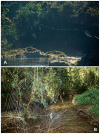Bioprospecting finds the toughest biological material: extraordinary silk from a giant riverine orb spider
- PMID: 20856804
- PMCID: PMC2939878
- DOI: 10.1371/journal.pone.0011234
Bioprospecting finds the toughest biological material: extraordinary silk from a giant riverine orb spider
Abstract
Background: Combining high strength and elasticity, spider silks are exceptionally tough, i.e., able to absorb massive kinetic energy before breaking. Spider silk is therefore a model polymer for development of high performance biomimetic fibers. There are over 41,000 described species of spiders, most spinning multiple types of silk. Thus we have available some 200,000+ unique silks that may cover an amazing breadth of material properties. To date, however, silks from only a few tens of species have been characterized, most chosen haphazardly as model organisms (Nephila) or simply from researchers' backyards. Are we limited to 'blindly fishing' in efforts to discover extraordinary silks? Or, could scientists use ecology to predict which species are likely to spin silks exhibiting exceptional performance properties?
Methodology: We examined the biomechanical properties of silk produced by the remarkable Malagasy 'Darwin's bark spider' (Caerostris darwini), which we predicted would produce exceptional silk based upon its amazing web. The spider constructs its giant orb web (up to 2.8 m(2)) suspended above streams, rivers, and lakes. It attaches the web to substrates on each riverbank by anchor threads as long as 25 meters. Dragline silk from both Caerostris webs and forcibly pulled silk, exhibits an extraordinary combination of high tensile strength and elasticity previously unknown for spider silk. The toughness of forcibly silked fibers averages 350 MJ/m(3), with some samples reaching 520 MJ/m(3). Thus, C. darwini silk is more than twice tougher than any previously described silk, and over 10 times better than Kevlar®. Caerostris capture spiral silk is similarly exceptionally tough.
Conclusions: Caerostris darwini produces the toughest known biomaterial. We hypothesize that this extraordinary toughness coevolved with the unusual ecology and web architecture of these spiders, decreasing the likelihood of bridgelines breaking and collapsing the web into the river. This hypothesis predicts that rapid change in material properties of silk co-occurred with ecological shifts within the genus, and can thus be tested by combining material science, behavioral observations, and phylogenetics. Our findings highlight the potential benefits of natural history-informed bioprospecting to discover silks, as well as other materials, with novel and exceptional properties to serve as models in biomimicry.
Conflict of interest statement
Figures




References
-
- Booth C, Price C. Oxford, UK: Pergamon Press; 1989. Comprehensive Polymer Science: The Synthesis, Characterization, Reactions, and Applications of Polymers.
-
- Guan ZB. Supramolecular design in biopolymers and biomimetic polymers for properties. Polymer International. 2007;56:467–473.
-
- Gosline JM, Demont ME, Denny MW. The structure and properties of spider silk. Endeavour. 1986;10:37–43.
-
- Gosline JM, Guerette PA, Ortlepp CS, Savage KN. The mechanical design of spider silks: From fibroin sequence to mechanical function. Journal of Experimental Biology. 1999;202:3295–3303. - PubMed
-
- Vollrath F, Knight DP. Structure and function of the silk production pathway in the spider Nephila edulis. International Journal of Biological Macromolecules. 1999;24:243–249. - PubMed
Publication types
MeSH terms
Substances
LinkOut - more resources
Full Text Sources
Other Literature Sources

